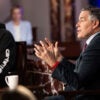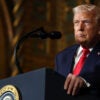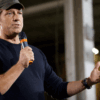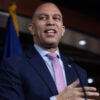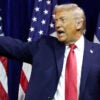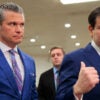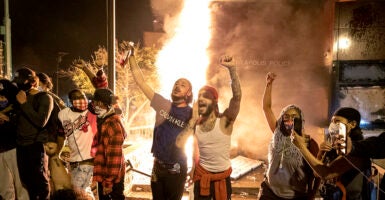Minnesota Gov. Tim Walz’s record amid the 2020 George Floyd riots in Minneapolis has received renewed scrutiny after Vice President Kamala Harris, the presumptive Democratic nominee for president, selected him as her running mate.
“Minnesota was ground zero for the Black Lives Matter riots of 2020. Harris egged it on, and Walz sat by and let Minneapolis burn,” Florida Gov. Ron DeSantis, a Republican, posted on X on Tuesday.
Harris, then a senator from California who had suspended her presidential campaign, had touted the Black Lives Matter protests even after many of them descended into violent riots.
“This is a movement, I’m telling you,” Harris told CBS “Late Show” host Stephen Colbert in June 2020. “They’re not going to stop. And everyone, beware, because they’re not going to stop. They’re not going to stop before Election Day in November, and they’re not going to stop after Election Day. And that should be—everyone should take note of that, on both levels, that they’re not going to let up, and they should not, and we should not.”
News outlets such as The Associated Press claimed that Harris was referring to the protests, not the riots, but she did not draw a clear distinction at the time. Only in August did she finally explicitly condemn the riots.
Harris also notably urged supporters to send money to the Minnesota Freedom Fund, which posted bail for the rioters in Minnesota. (Fact-checkers later established that Harris never personally donated to the Freedom Fund herself, though she and others helped direct more than $40 million to the organization at the time.)
A time line of the riots in Minneapolis will help explain Walz’s record. The Minnesota-based Center of the American Experiment informed this time line.
Mayor Asks Walz for National Guard
George Floyd died in police custody in Minneapolis on Monday, May 25, 2020. A jury later convicted of second-degree murder the police officer who kneeled on Floyd’s body during his death. Thousands of protesters took to the streets on the day after Floyd’s death, and some smashed windows. By Wednesday, May 27, rioters had looted stores, including a Target, and arsonists had set at least 30 fires, including a blaze that gutted a six-story affordable-housing apartment building still under construction.
Minneapolis Mayor Jacob Frey, a Democrat, called Walz at 6:29 p.m. that evening, asking him to send in the National Guard, the Minneapolis Star Tribune later reported.
“We expressed the seriousness of the situation. The urgency was clear,” Frey said. “He did not say yes. He said he would consider it.”
“Frey insisted that he explicitly asked whether his verbal requests constituted a formal request, and the governor’s staff confirmed that they did,” the Star Tribune reported. “The governor’s office disputes that.”
Yet the newspaper obtained records corroborating that Frey called the governor and that Frey later indicated that “Walz was hesitating.”
At 9:11 p.m., then-Minneapolis Police Chief Medaria Arradondo sent an email to Public Safety Commissioner John Harrington including an attachment requesting “assistance of the MN National Guard for immediate assistance with significant civil unrest occurring in the City of Minneapolis.” The document stated that the police department had “expended all available resources within our Department as well as all available law enforcement assistance from our neighboring jurisdictions.”
Arradondo requested 600 National Guard soldiers, as well as vehicles.
The mayor’s office sent another request for the National Guard at 10:55 a.m. on Thursday, May 28, noting “widespread looting and arson,” along with injuries sustained by protesters and first responders.
Walz Activates the Guard
Walz finally activated the National Guard at 2:30 p.m. Thursday, 18 hours after Frey asked him to do so. Walz’s spokesman, Teddy Tschann, said the governor needed more information to deploy the soldiers.
“As a 24-year veteran of the Minnesota National Guard, Governor Walz knows how much planning goes into a successful mission,” Tschann said at the time. “That’s why he pushed the City of Minneapolis for details and a strategy. He ordered the Minnesota National Guard to start preparing Thursday morning, which allowed them to deploy to both St. Paul and Minneapolis that evening, per the Mayors’ requests.”
Yet the National Guard did not arrive on scene that afternoon. As the Star Tribune reported, soldiers went to other locations, including the Capitol in St. Paul, but troops did not arrive at the south Minneapolis area of the Third Precinct—the site of the worst rioting—until almost 4 a.m. on Friday, May 29, by which time most rioters had left and the precinct had been burning for hours.
National Guard Bureau spokesman Rob Perino said Walz was in charge of the time line. “The governor’s office directs the National Guard to respond—when and where,” he said. “That’s how any state will tell you it goes.”
On Friday morning, Walz shifted most of the blame to Frey, condemning his “abject failure” to handle the crisis. Then he revealed a potential reason why he delayed, in a statement that the Center of the American Experiment’s John Phelan and Tom Steward described as “validating anger towards the police.”
“The very tools that we need to use to get control, to make sure that buildings aren’t burned and the rule of law collapses, are those very institutional tools that have led to that grief and pain,” he said.
Maj. Gen. Jon Jensen, then adjutant general of the Minnesota National Guard, explained that guardsmen had been mustered that evening and awaited orders, which he said should have come from Frey. Walz said he deferred to local officials, stressing his fears that the sight of the National Guard might further inflame the situation.
Walz did accept some responsibility. “If the issue was the state should’ve moved faster, yeah, that is on me,” he admitted.
A Broken Promise
Walz promised that Friday night would be different. “There will be no lack of leadership, and there will be no lack of response on the table,” he said. The governor even said he would consider imposing martial law, and he declared an 8:00 p.m. to 6:00 a.m. curfew for Minneapolis and St. Paul.
Yet when the curfew arrived, no one attempted to enforce it, and the riots began again, with looting, arson, and general mayhem returning to the streets of Minneapolis. As a Japanese restaurant, a Wells Fargo bank, and an Office Depot—among others—burned, firefighters failed to reach them because the areas weren’t secure.
Just before midnight and into early Saturday, May 30, hundreds of police officers, state troopers, and National Guard troops moved in, confronting rioters and ordering them to disperse. At 1:30 a.m., Walz and Frey held an emergency press conference, begging the rioters to go home.
That Saturday morning, then-President Donald Trump threatened to send in the military in a show of strength.
Finally, the National Guard mobilized in effective numbers. More than 1,000 additional citizen-soldiers and airmen joined the 700 who had been on duty the day before. By midday Saturday, the number reached 2,500 personnel. “The governor just announced the full mobilization of the Minnesota National Guard for the first time since World War II,” Jensen, the National Guard leader, said at the time.
After four nights of violent riots, the National Guard finally restored relative order, suggesting that Walz could have prevented much of the destruction.
Walz’s Mindset
In October 2020, the Minnesota Senate’s Transportation and Judiciary and Public Safety committees released a report detailing the state government’s response to the riots. That report shone important light on the apparent mindset behind Walz’s delay, based on hearings the committee conducted.
“There is philosophically an argument to be made that an armed presence on the ground in the midst of where we just had a police killing is seen as a catalyst,” Walz stated in the hearings. While he admitted that the catalyst had already occurred and more officers and troops should have been present since the city was already burning, he added that he had been trying to strike a balance between more law enforcement and appeasing the rioters.
“The result was on the night of Friday, May 29, after his comments stating more officers and Minnesota National Guard were necessary, law enforcement was not out in full force that night to protect citizens,” the report states.
Walz said that “deciding when to move and with what level of force was a delicate balance.” He stressed the importance of “understanding what the community needs, but not coming in heavy-handed with them.”
When denouncing the violence and destruction in the riots, Walz’s office told staff that “[h]aving monitored social [media] of other electeds today, we need to be very careful with messaging like this as not to be tone-deaf or dismissive … or put property above people.”
Dismissing the lawlessness and destruction as putting “property over people” featured in the Left’s responses to the riots suggested that bringing law and order would be counterproductive. Yet the riots claimed the lives of at least 26 people and resulted in more than $2 billion in paid insurance claims, becoming the most destructive riots in U.S. history.
Walz, as governor of Minnesota during the riots, had a leadership position at ground zero. His delayed response arguably reveals his sympathies for the rioters and his willingness to shift responsibility to avoid blame.
Walz’s office did not immediately respond to a request for comment. This article will be updated with any response.
